Byddi Lee's Blog, page 11
March 27, 2018
Time Travel at the Armagh Museum
A good friend recently put me in touch with Sean Barden, at the Armagh County Museum when I expressed an interest in writing some short stories set in the past and based on actual events in history. We discussed how objects from the past had their own stories, and I was invited to come down to the museum to see the temporary exhibit they have at the moment entitled Telling People's Stories for 80 Years.
"You might remember Humpy the camel from Lenox's," he said.
"Oh my God, you have Humpy the camel!" I clapped my hands with delight.
Apparently, I wasn't the only one who had reacted like that.
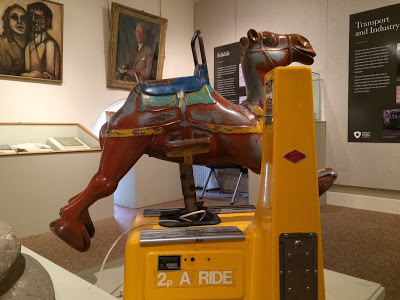 Photograph courtesy of the Armagh County Museum
Photograph courtesy of the Armagh County Museum
Every Armagh child who ever went into Lennox's Department Store knew Humpy. He was one of those coin-operated rides that made children beg their parents for the money to take a ride that lasted a fraction of the time it took to procure the funding - a lesson for life indeed!
I loved how Humpy looked - he wasn't humpy by nature - his face molded and painted in a friendly smile, his legs in a perpetual gallop. And he hadn't changed one bit when I spotted him in The Armagh County Museum. In fact, it was all I could do to stop myself from patting his nose, now worn bare of paint from years of people doing the same. Since I had my museum manners on, I quashed the urge to throw my arms around his neck and whisper, "Take me away!"
The museum has 3 temporary exhibit areas and at the moment all three are being used. We took a walk through the exhibit, Eye in the Sky - a display of aerial photographs from a time long before we could send a drone up for such snaps. It's fascinating to see familiar landscapes from that angle and era. I could happily spend more time browsing these - oh, but when would we have another rainy afternoon here in Armagh to do such things?
Humpy is one of forty objects as the signage at the museum explains...
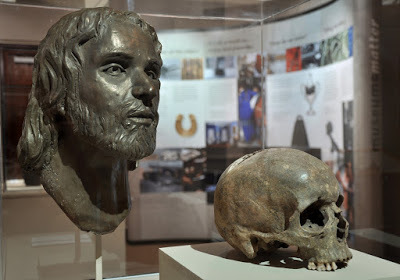 Photograph courtesy of the Armagh County Museum
Photograph courtesy of the Armagh County Museum
Take item number 6, for example. A human skull and reconstructed head. Who was that man?
We can see the hole in his skull, so no medals for guessing how he died.We are told that it was between 1000 and 1300AD and that he was aged between 25 and 35. The skull was found without a body during a dig in Market Street, which would suggest that he was decapitated.
Did his head roll into a ditch? Was a loved one left to wonder where that person (or even worse just the head) was until the end of their days? Was he a bad person? Had he deserved this end? Or is this the heartbreaking story of a man viciously wronged? Does his ghost still walk Market Street?
Beside the skull is a reconstructed model of what that man might have looked like. He was handsome and young.
 Photograph courtesy of the Armagh County Museum
Photograph courtesy of the Armagh County Museum
The little patch box (number 17), though tiny, spoke of much bigger issues. This little box was used to hold the beauty spots that women wore on their faces. If you read the pamphlet that accompanies the exhibit you'll learn from the clues on the container that this may have been quite the radical item to receive or gift to a secret lover perhaps! Find out more yourself at the museum.
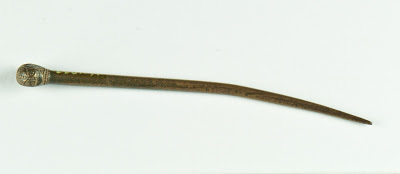 Photograph courtesy of the Armagh County Museum
Photograph courtesy of the Armagh County Museum
Object numbered 8 is a stick pin found in a garden in Callan street. Linger a moment here. Focus in on the head of the pin and examine the fine detail.
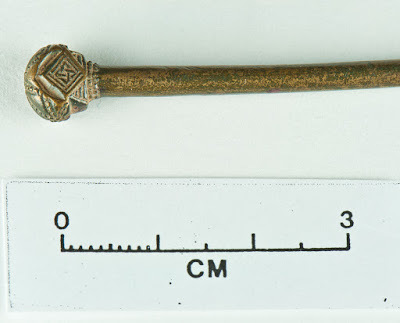 Photograph courtesy of the Armagh County MuseumWho took the time to make this and why spend so much time on tiny details that many might overlook?
Photograph courtesy of the Armagh County MuseumWho took the time to make this and why spend so much time on tiny details that many might overlook?
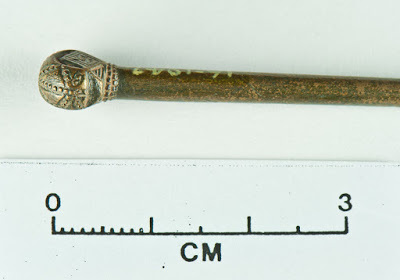 Photograph courtesy of the Armagh County Museum
Photograph courtesy of the Armagh County Museum
I like the idea that this workmanship did pay off, that somehow the craftsman in the afterlife knows that we are still admiring his work.
 Photograph courtesy of the Armagh County Museum
Photograph courtesy of the Armagh County Museum
These are but four objects in the exhibition - each if the others gave pause for thought in a similar way. It was so wonderful to get time away from the desk, from the screen (phone, tv, computer) and just have a look at real things. The museum is free in and a great change of pace. Often we don't appreciate the treasures on our own doorstep and the Armagh County Museum really is one.
For me, the biggest revelation was learning the true purpose of a museum. While viewing bronze axes for the story I was researching, I commented on how good it would be to have a bigger museum to display more of the objects in storage. I was surprised when told that although a larger museum would be great, the ultimate aim was not to put every item in the collection on display. Actually, when objects are in storage it is easier to control their environment and thus preserve them better.
The job of a museum is not in fact to display everything it has collected but to keep that collection safe. Storerooms are not just some "dusty oul' sheds" somewhere. Museum storage is working storage, accessible storage where each object is easy to find. Even when in storage each object is there for anyone who wants to look at it. A museum is essentially a collections resource centre, a library of objects. The Armagh County Museum has been collecting objects for 80 years and some of these objects date back as far as 9000 years ago.
It is not about restoring an object either - this implies that you are changing the object. It's about making the object stable - taking a snapshot of time then trying to preserve the past - making time stand still. I joked with Sean telling him he was, in fact, a time lord - Armagh's very own Doctor Who!
A tour of the stores had me fascinated. It was so tidy and clean and - joy of joys - labelled! A clutterphobes heaven in an oxymoronic way. The museum has an ongoing project to photograph everything it holds - like the stick pin. If you were doing a project, the museum will let you use their photos - all the photos on this post have been supplied by the museum. They are much better than anything I could take.
I learned something eye-opening on that visit - the museum is for more than browsing on a rainy day (though that's cool too.) But if you wanted to research anything that has its roots in the past the museum is the place to go. Sean made me laugh out loud with his next truism - "It's about getting past the posh frocks and the stuffed fox..."
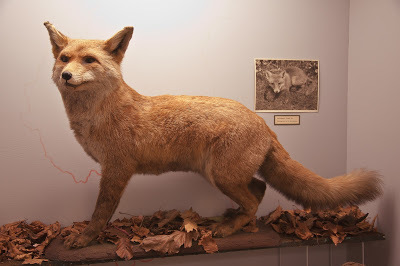 Photograph courtesy of the Armagh County Museum
Photograph courtesy of the Armagh County Museum
So do yourself a favour, tear yourself away from your screens and get down there - in person - to have a poke through moments in time.
On Saturday 31st March 2018 they are having a Family Fun Day and there will be owls - live owls! For more information click this link - https://visitarmagh.com/whatson/easter-family-fun-at-the-museum/
Maybe see you down there on Saturday.
Byddi Lee

"You might remember Humpy the camel from Lenox's," he said.
"Oh my God, you have Humpy the camel!" I clapped my hands with delight.
Apparently, I wasn't the only one who had reacted like that.
 Photograph courtesy of the Armagh County Museum
Photograph courtesy of the Armagh County MuseumEvery Armagh child who ever went into Lennox's Department Store knew Humpy. He was one of those coin-operated rides that made children beg their parents for the money to take a ride that lasted a fraction of the time it took to procure the funding - a lesson for life indeed!
I loved how Humpy looked - he wasn't humpy by nature - his face molded and painted in a friendly smile, his legs in a perpetual gallop. And he hadn't changed one bit when I spotted him in The Armagh County Museum. In fact, it was all I could do to stop myself from patting his nose, now worn bare of paint from years of people doing the same. Since I had my museum manners on, I quashed the urge to throw my arms around his neck and whisper, "Take me away!"
The museum has 3 temporary exhibit areas and at the moment all three are being used. We took a walk through the exhibit, Eye in the Sky - a display of aerial photographs from a time long before we could send a drone up for such snaps. It's fascinating to see familiar landscapes from that angle and era. I could happily spend more time browsing these - oh, but when would we have another rainy afternoon here in Armagh to do such things?
Humpy is one of forty objects as the signage at the museum explains...
"Armagh County Museum – Telling people’s stories for 80 years.
Armagh Natural History & Philosophical Society moved their museum into this building in 1856. However it would be another 60 years before the county museum was born.
When Armagh County Council took over the premises in 1930 and Council Secretary T.E. Reid was influential in getting local historian T.G.F. Paterson appointed as Honorary Curator. Paterson spent the next seven years building up a collection relevant to the history of the area and disposing of many of the Philosophical Society’s more unusual ‘curiosities’.
Armagh County Museum officially opened on 28 April 1937 and was the first dedicated county museum in Ireland.
A helpful booklet is provided that tells a little about what is known about each object (numbered for easy referencing) and I invite you to fill in the rest with your imagination.
To mark its 80th year we have chosen a selection of objects from the collection that tell the stories of people who have lived, worked and been associated with the Orchard County over the past 9,000 years."
 Photograph courtesy of the Armagh County Museum
Photograph courtesy of the Armagh County MuseumTake item number 6, for example. A human skull and reconstructed head. Who was that man?
We can see the hole in his skull, so no medals for guessing how he died.We are told that it was between 1000 and 1300AD and that he was aged between 25 and 35. The skull was found without a body during a dig in Market Street, which would suggest that he was decapitated.
Did his head roll into a ditch? Was a loved one left to wonder where that person (or even worse just the head) was until the end of their days? Was he a bad person? Had he deserved this end? Or is this the heartbreaking story of a man viciously wronged? Does his ghost still walk Market Street?
Beside the skull is a reconstructed model of what that man might have looked like. He was handsome and young.
 Photograph courtesy of the Armagh County Museum
Photograph courtesy of the Armagh County MuseumThe little patch box (number 17), though tiny, spoke of much bigger issues. This little box was used to hold the beauty spots that women wore on their faces. If you read the pamphlet that accompanies the exhibit you'll learn from the clues on the container that this may have been quite the radical item to receive or gift to a secret lover perhaps! Find out more yourself at the museum.
 Photograph courtesy of the Armagh County Museum
Photograph courtesy of the Armagh County MuseumObject numbered 8 is a stick pin found in a garden in Callan street. Linger a moment here. Focus in on the head of the pin and examine the fine detail.
 Photograph courtesy of the Armagh County MuseumWho took the time to make this and why spend so much time on tiny details that many might overlook?
Photograph courtesy of the Armagh County MuseumWho took the time to make this and why spend so much time on tiny details that many might overlook? Photograph courtesy of the Armagh County Museum
Photograph courtesy of the Armagh County MuseumI like the idea that this workmanship did pay off, that somehow the craftsman in the afterlife knows that we are still admiring his work.
 Photograph courtesy of the Armagh County Museum
Photograph courtesy of the Armagh County MuseumThese are but four objects in the exhibition - each if the others gave pause for thought in a similar way. It was so wonderful to get time away from the desk, from the screen (phone, tv, computer) and just have a look at real things. The museum is free in and a great change of pace. Often we don't appreciate the treasures on our own doorstep and the Armagh County Museum really is one.
For me, the biggest revelation was learning the true purpose of a museum. While viewing bronze axes for the story I was researching, I commented on how good it would be to have a bigger museum to display more of the objects in storage. I was surprised when told that although a larger museum would be great, the ultimate aim was not to put every item in the collection on display. Actually, when objects are in storage it is easier to control their environment and thus preserve them better.
The job of a museum is not in fact to display everything it has collected but to keep that collection safe. Storerooms are not just some "dusty oul' sheds" somewhere. Museum storage is working storage, accessible storage where each object is easy to find. Even when in storage each object is there for anyone who wants to look at it. A museum is essentially a collections resource centre, a library of objects. The Armagh County Museum has been collecting objects for 80 years and some of these objects date back as far as 9000 years ago.
It is not about restoring an object either - this implies that you are changing the object. It's about making the object stable - taking a snapshot of time then trying to preserve the past - making time stand still. I joked with Sean telling him he was, in fact, a time lord - Armagh's very own Doctor Who!
A tour of the stores had me fascinated. It was so tidy and clean and - joy of joys - labelled! A clutterphobes heaven in an oxymoronic way. The museum has an ongoing project to photograph everything it holds - like the stick pin. If you were doing a project, the museum will let you use their photos - all the photos on this post have been supplied by the museum. They are much better than anything I could take.
I learned something eye-opening on that visit - the museum is for more than browsing on a rainy day (though that's cool too.) But if you wanted to research anything that has its roots in the past the museum is the place to go. Sean made me laugh out loud with his next truism - "It's about getting past the posh frocks and the stuffed fox..."
 Photograph courtesy of the Armagh County Museum
Photograph courtesy of the Armagh County MuseumSo do yourself a favour, tear yourself away from your screens and get down there - in person - to have a poke through moments in time.
On Saturday 31st March 2018 they are having a Family Fun Day and there will be owls - live owls! For more information click this link - https://visitarmagh.com/whatson/easter-family-fun-at-the-museum/
Maybe see you down there on Saturday.
Byddi Lee

Published on March 27, 2018 07:35
March 24, 2018
Flash Fiction Armagh – The First of Many…
When I was young, I thought that all things literature were boring and decidedly stuffy. Many people, having suffered through Shakespeare and Thomas Hardy at school, still think like that about the literary world but last night’s Flash Fiction Armagh turned that idea completely on its head!
Eleven talented writers wowed the socks off the audience in the upstairs room of Mulberry Bistro in Armagh.
Let me begin by describing the gorgeous venue. Mulberry Bistro is in an old but beautifully restored building right across the road from one of Armagh’s cathedrals. Decorated in a simple rustic fashion, touches of glamour such as crystal chandelier light fittings and plush velvet seating in a range of fun colours add the right amount of pop.
Réamonn Ó Ciaráin, author of Cúchulainn, Ulster’s Greatest Hero, and co-host of Flash Fiction Armagh was already there when I arrived to set up for the evening. Mulberry handed over their upstairs room, offering to move chairs and tables into any configuration we wanted – they were happy to let us complete rearrange the room to suit our needs. It didn’t take long – the place already the perfect venue.
The Cathedral, lit up as night fell, looking in the windows at us as people arrived. It was pure Armagh – looking beautiful and majestic. My home.
All the writers arrived on time and to our great delight, the audience filled the room. The table closest to the mic the only one with no takers – people hate sitting at the front!
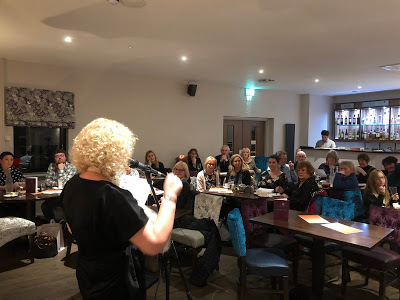
None of us had expected such a good turnout, but Mulberry Bistro rose to the occasion feeding and watering everyone as needed. Nerves had prevented me from having a big dinner but a tasty caramel square and a coffee set me up. All in and settled, it was time for our first reader.
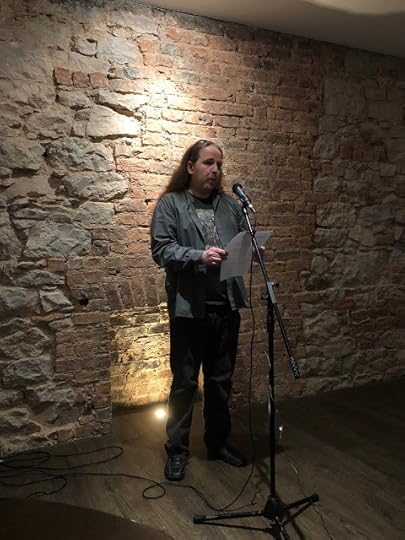
Local writer, Jay Faulker got us off to a great start with his story Rain, an emotive account of a firefighter’s attempts to save two little boys from drowning.
Brilliantly told, I knew the story would strike a cord when I’d read it during the selection process and I wasn’t disappointed. I could actually see members of the audience relax into the evening as they listened – none of us had known exactly how this venture would go, but as Jay read I knew we’d done something right.
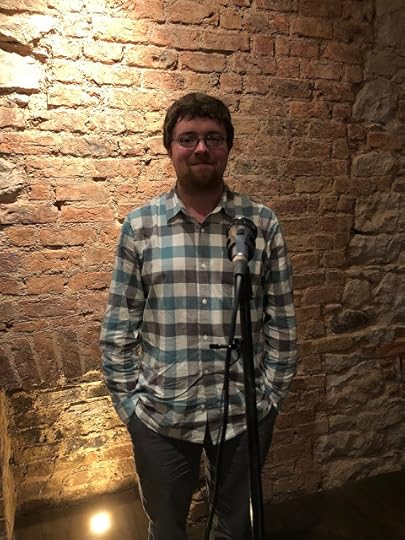
Christopher Moore from Broughshane enthralled us with the magic of his piece Dark Hedges.
I particularly loved his hints at a magical other world and felt that he’d claimed those hedges back from Game of Thrones and made them ours again. His mastery of language and sense of flow captured our interest and imagination, bringing some solace after the intense drama of the first piece.

Réaltán Ní Leannáin from Belfast via Dublin read Dílis,
...expertly switching from between the Irish and English languages so that everyone could enjoy and appreciate the zesty humour in her story about a little protestant girl so enamoured with the holy communion dresses the little catholic girls are wearing that she begs her mother to let her be a Catholic – just for a day! Réaltán left us all with smiles on our faces.

Keady man, Damien Mallon read a selection of his poems that were such a hit he sold out of his book, Reading the Trees, at the intermission!
His combination of humour, sensitivity and vivid imagery took us through awkward encounters at parent-teacher meetings, wistful reminiscing at graveyard Sunday and a walk through Carnagh woods such that you felt you were there.
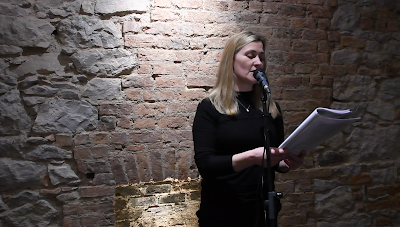
Donegal/Derry writer Pamela Brown’s Mansfield House was so skillfully rendered that it made the audience chuckle in places then fall pin-drop silent with emotion in others.
This story pulled us in, led us around a blind corner then smacked home some tough but unavoidable truths. Engaging and honest, Pamela pulled no punches and we were richer for it.

Before going into the break Réamonn Ó Ciaráin from Armagh read from Laoch na Laochra a book in modern Ulster Irish about Cúchulainn...
...and followed that with reading the corresponding passage from the English Language version Cúchulainn, Ulster’s Greatest Hero.
In both languages, the power of the writing and the story it carried shone through. We headed into the intermission filled with wonder and awe.
People mingled, bought books, congratulated readers and the general atmosphere was a delightful hub-bub though I wondered how I’d ever get everyone settled back down again for the second half.

No need to worry – so the 15-minute break drifted into 25 minutes – soon everyone was ready to listen to Trish Bennett from Enniskillen read Power of a Peeler.
Her entertaining performance provoked belly laughs from her audience as she explained how important a certain kitchen utensil was to her and her extended family. She even produced the subject of the story to gales of laughter.

Lisburn writer Karen Mooney’s A Fond Farewell moved every person in the room with her emotive piece remembering her father.
The words beautiful and heartfelt dripped upon a captive audience like honey from a spoon, sorrowful yet soothing. When she finished, the momentary silence was as much an accolade at the spontaneous applause that followed.

Reading in Irish, Armagh man Seán Ó Farraigh gave a beautiful rendition of his story Neamhchiontach go dtí go gcruthaítear a mhalairt.
I grasped at words and phrases I recognized, desperate to understand this lilting and musical language. This young man’s bilingual skill inspired me to consider attending Irish language classes myself – with the new Irish Language centre on its way here in Armagh, I really have no excuse!

Catherine Carson from Crossgar made everyone’s ears tingle and skin goosebump with the power of Spectrum, a story of a mother with her grown-up autistic son.
A collective “Awe,” at the end of her account, gave instant, and I’d imagine, gratifying feedback to the writer of a story outstanding in its perception, construction and delivery. This new writer is one to watch. (You heard it first at Flash Fiction Armagh!)
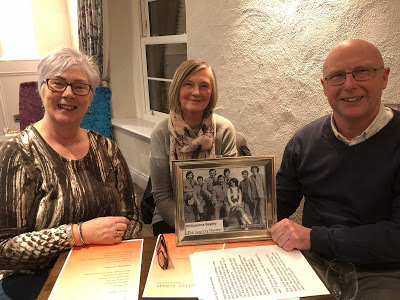 Malachi showing a picture of the suits in Scoring in the SeventiesThough it was a hard act to follow, Malachi Kelly from Armagh brought the house down with his amusing story Scoring in The Seventies, about how a new suit sets hearts and minds alight in 1970’s Armagh.
Malachi showing a picture of the suits in Scoring in the SeventiesThough it was a hard act to follow, Malachi Kelly from Armagh brought the house down with his amusing story Scoring in The Seventies, about how a new suit sets hearts and minds alight in 1970’s Armagh. Leaving us smiling and uplifted, it was a perfect way to end the evening.
By the time we brought the evening to a close, it was decided that this would not be the last Flash Fiction Armagh. It turned out that Mulberry Bistro loved hosting us as much as we loved being there – an event marriage in the making. The feedback forms begged us to have another evening as soon as possible. When people were asked about the venue, the vote was in – Mulberry Bistro was ideal – classy, intimate and welcoming.
There were about half a dozen people in the audience who were there because I’d asked them to come as my friend/family to support our first event. At the outset, I looked upon their attendance as a favour to me – it may not be their cup of tea. I worried that I was putting them out but valued their support, loved them for it in fact. But by the end of the evening, I realized something – this event, these readers, our selections had reached every member of the audience, more than once and in more than one way. The event had been a success for all of us because good writing is about describing the human condition and connecting us to one another, no matter who we are and what we believe. Flash Fiction Armagh extended beyond my preconceived ideas of what literature should or should not be. Flash Fiction Armagh connected us to one another however fleetingly and I am confident it will do so again. We hope to have the next event in June and will post details on this blog and the Armagh Writers Facebook page as soon as details are confirmed.
Byddi Lee

Published on March 24, 2018 05:36
March 6, 2018
Flash Fiction Armagh Presents
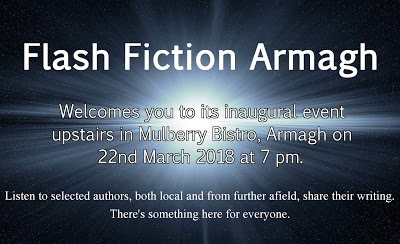
We had a fabulous response to the call for submissions for Flash Fiction Armagh.
The high standard of writing gave us some difficulty making our final selection, but we are delighted to present the following writers at our inaugural Flash Fiction Armagh on Thursday 22nd March 2018 at 7pm.
In no particular order, congratulations to:
Jay Faulker, Rain
Catherine Carson, Spectrum
Réaltán Ní Leannáin, Dílis
Damien Mallon, Reading The Trees
Pamela Brown, Mansfield House
Réamonn Ó Ciaráin, The Boy Corps of Eamhain Mhacha
Trish Bennett, Power of a Peeler
Karen Mooney, A Fond Farewell
Seán Ó Farraigh, Neamhchiontach go dtí go gcruthaítear a mhalairt
Christopher Moore, The Dark Hedges
Malachi Kelly, Scoring in the Seventies
Sharon Dempsey*, The Watcher
So please come along and be a part of the first ever Flash Fiction Armagh.
A big thank you to Mulberry Bistro for generously hosting the event in their gorgeous upstairs room allowing us to keep the event free. No better location, with our beautiful Cathedral looking on through their windows!

Byddi Lee
* Sharon Dempsey is unable to make it to the event in March, but we hope to see her at a subsequent event.

Published on March 06, 2018 02:43
February 26, 2018
The Charlemont Arms Hotel, Armagh - there's always a warm welcome and a log on the fire.

My Granny loved a wee meal in the Charlemont Hotel. We celebrated her 80th birthday there and a few years later celebrated her life with a meal there after her funeral. It was also where we celebrated my nephews' christening. I have fond memories of dancing with My Dad at credit Union AGMs. He was great at the jiving and taught My Sister and me how to dance in our kitchen. Nearly 10 years after his passing, I was back dancing in that same room, this time to the Celtic Rock Legends, Horslips at the John O Connor Writing Festival.
The Charlemont Hotel has been the venue for many of the beats of my life, and it's a great wee spot for a cosy meal and a drink with friends between those times.
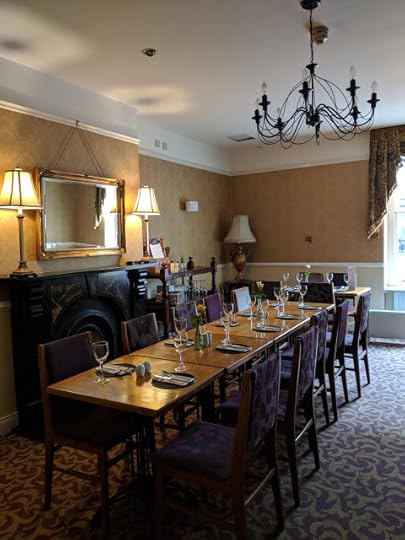
Last August, I was sitting in the queue one day in Argos in Armagh when a woman sat down beside me.
"I know you don't I?" we said to each other at the same time. It took us a few moments to place each other's face.
"I was talking to you the other night," I said. "I was in the Charlemont. You work there don't you?"
I'd had my hair cut that morning, and she said that was why it had taken her a moment to recognise me again. Turns out, Helen doesn't just work there, she and her sister, Judith, own the hotel. It didn't surprise me one bit to learn that The Charlemont was a family run business. It had always had a warmth to it, a sense of comfort and home that comes from family. Helen's friendliness was typical of what I've come to associate with the Charlemont Hotel. She was happy to sit down with me recently and tell me about her family's history at the hotel.
Helen's grandparents, Robert and Elizabeth Forster, bought the hotel in 1934. Her mum came to work in the office at the age of 14. As we chatted, I mentioned how romantic it must have been for this young woman going to work and meeting the hotel owner's son, catching his eye and falling in love. Helen gave me a look that told me I might be over romanticising things (as I am prone to doing) and said with a laugh, " Let's just say, love blossomed."
When I pressed it by saying that they probably went to the City Hall dances together Helen nodded and told me that the Charlemont had done the catering for those dances. My own parents had gone to those dances too.
Helen's parents took over running the hotel. In those days a lot of travelling salesmen and company reps stayed in the hotel. Her mother tells of how they used to leave their shoes out by their doors and the staff would take them away, polish them and return them before morning. There is still a room at the hotel called the "boot hall" where the shoes where polished. Often the reps would get up to high jinx, doing things like swapping around the shoes. I can imagine the temptation that would be after a few pints of Guinness in the bar!

That was all before Helen's time but she remembered the tea - loose tea, no tea bags - for the hotel arriving in big tea chests. I knew the type of thing she meant. We'd had one that we had stored old toys in. She also remembers coin operated heaters in the rooms.
There had been 18 rooms but some shared bathrooms. After renovations to give each room an ensuite there were 12 rooms. In 2000, the Charlemont bought Turners, the builders merchants next door and extended to 30 rooms, all with ensuite.

The hotel weathered the good times and the bad and throughout the years both sides of the community were welcomed and supported the hotel. Helen says she really appreciates that. I liked to hear it too. It gave me hope for a future where we can all live and work together here.
I asked Helen had she ever considered not going into the family business. She shrugged and said she'd spent a year in Boston, but even that was hotel related. She'd had worked in the 1000 room Boston Park Plaza which was, as Helen put it, "a bit different."
And indeed it is because the Charlemont Hotel has a good, comfortable vibe. It's an institution of old Armagh and has an atmosphere of home. People make friends here. There's always a log on the fire and the kettles always on the boil. Even when working during quiet times, when the place is empty, Helen says she never feels lonely or afraid in the hotel.

Helen did her degree in hotel tourism but says she learned more in the day-to-day running of the Charlemont when she and her sister took over the running of the hotel. She has certainly endeavoured to provide a cosy home-from-home experience for the people who frequent this much-loved establishment at the heart of the city.
The Charlemont Hotel is the pivotal venue of the John O Connor Writing School and Literary Festival held every year in November. Robert McCrum, Associate Editor, The Observer and author summed it up nicely when he urged the festival organizers,
"Don't get bigger, get better! The Charlemont is key to your success - such a great vibe..."
Come see for yourselves. Grab a good book and have a drink by the fire - I can suggest a few good ones - both in books and drinks!
Byddi Lee

Published on February 26, 2018 06:23
February 16, 2018
Full House at the Open Mic in the Abby Lane Theatre
The Open Mic Night at the Abbey Lane Theatre is a gleaming treasure hidden in a backstreet of Armagh City. Tucked behind a wall in a carpark where Linehall Street meets Abbey Lane, the door to the theatre bears little adornment. Once through that door, the stage is to the left and a large room stretches back to stairs beside an area with a sink and a structure that reminded me of our school tuckshop. Bare concrete walls play host to photos of happy groups of people in various costumes. I pick out some familiar faces.
 Image courtesy of The Armagh Theatre group website.
Image courtesy of The Armagh Theatre group website.
Tonight is the last Friday of January and the first Open Mic Night of 2018. The stage has been set up with clusters of chairs and some little tables upon which sit little bowls of crisps, as if to say, “make yourself at home.” The rest of the room centres on a lonely blue chair and the Mic midway down the hall. I like the inclusive and intimate set up.
We pay our cover charge. Malachi Kelly welcomes us in. He has an easy way of managing to chat with everyone, giving each a fair amount of his banter without looking hassled or making you feel you’re in the way.
The burble of voices in the room rises as the seats fill in. Friends acknowledge each other, women embrace, men shake hands and clap backs. The audience is diverse – male, female, young, middle-aged, and older. There are people here from Lurgan, Belfast, and possibly further afield judging by the accents I hear.
The room is full, every seat taken, and a couple of young girls sit on the stairs having given up their seats to a more mature couple of late-comers.
Malachi takes the Mic, taps it a few times, then sets it aside. He starts, “In the name…” Those magic words, many of the audience know from school days as the way to quiet a crowd. Apart from the swell of gentle laughter, it works. Everyone settles in to listen and from what I can see are captured in the magic that the performers spin over the next couple of hours.
First up is Poet Mel Mc Mahon, originally from Lurgan reading poetry from his book Out of Breath. I can tell from the pin-drop silence that he has connected with the audience and he carries us along with his mastery of words.

Next up is Thomas Healy on the harp and we let our minds melt with the resonance of the strings. Later in the evening, his soulful yet gritty poetry leaves a lasting impression.
Then Dymphna Ferran gets to her feet, looking like butter wouldn’t melt but brings the house down with her stand-up comedy act.

When John Goodman starts to sing, a respectful silence settles over the listeners. It seems his reputation precedes him, and rightly so. Sung in an old tradition of reciting story, his voice is clear and melodic and the narrative easy to follow.
Colin Dardis, all the way from Belfast, reads poems so good that I get prickles on my scalp as his words wriggle under my skin.

We roll into the intermission with a beautiful song from Daniel Corrigan.
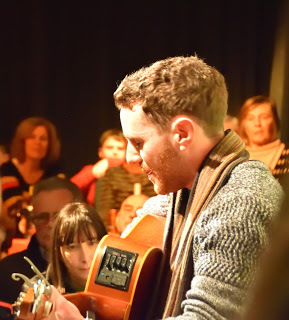
Even the break is a bit of craic as people move about, chatting with friends, congratulating performers. It’s nice to be able to approach people unselfconsciously and strike up a conversation. The atmosphere is simply that convivial.
Malachi launches the second half with what can only be described as a controlled riot. It’s time for the Limerick competition, too many contestants to name but all raising a laugh. There’s prizes – a meal for two, a bottle of wine, chocolates. I’m impressed at the list. To determine who wins, Malachi produces a Clapometer on his iPad. The audience decides it has one mission, and one mission only – to get that needle to the max, regardless of who said which limerick. It’s daft craic in its best Armagh fashion.
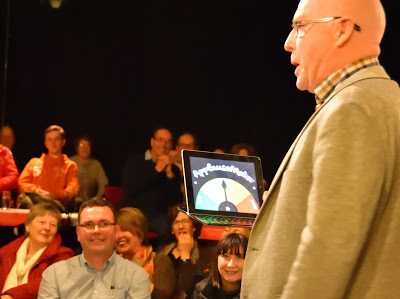
Finally, somehow, Malachi declares a winner and presents the meal for two…a couple of packets of Tayto crisps, delivered by air mail as he flings them over the heads of the audience. Local produce all the way!
Peter Carragher from Cullyhanna via Gilford enthrals the house with his aural storytelling, word perfect, without prompting from page or phone, an impressive feat which I think the younger generations would find hard to match.
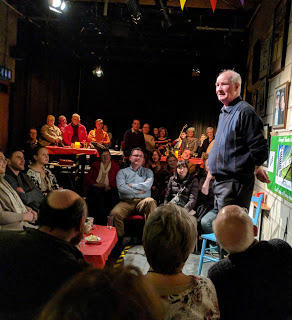
Geraldine Daris O Kane reads a powerful poem that explores what it means to be human in our connections and our projections of who we think we are.
Young Louis O Donnell entertains us on his banjo. It is great to see the youth joining in and sharing their talents too.
Kevin Trainer has the whole place singing with him as he sings a song about Armagh characters from days gone by.
A somewhat experimental piece, the Mc Cools pull off a delightful narrated tin whistle instrumental. Musical talent is obviously a thing here in Armagh as singers Theresa, Michael Callaghan and Pat Prunty illustrate.
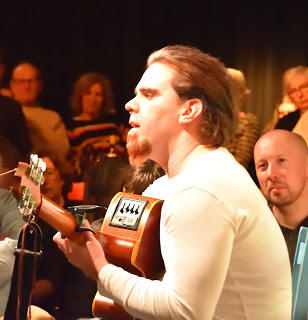 Tomas Healy
Tomas Healy
As the night comes to a close, again, we mingle. The Abbey Lane Theatre is a place with heart, a place to reconnect with old acquaintances and make new ones, a place to share stories and enjoy talent. It’s a place to enjoy a lovely night out on our doorstep, and I for one, am glad I discovered this place.
Open Mic at the Abbey Lane Theatre takes place on the last Friday of every month at 8pm and costs £5.
For more information check out their website – http://www.armaghtheatregroup.com/
Next Friday, the talented poet, David Braziel leads the charge. It promises to be a great nights craic so get down there early and grab the best seats!
Byddi Lee
 Image courtesy of The Armagh Theatre group website.
Image courtesy of The Armagh Theatre group website.Tonight is the last Friday of January and the first Open Mic Night of 2018. The stage has been set up with clusters of chairs and some little tables upon which sit little bowls of crisps, as if to say, “make yourself at home.” The rest of the room centres on a lonely blue chair and the Mic midway down the hall. I like the inclusive and intimate set up.
We pay our cover charge. Malachi Kelly welcomes us in. He has an easy way of managing to chat with everyone, giving each a fair amount of his banter without looking hassled or making you feel you’re in the way.
The burble of voices in the room rises as the seats fill in. Friends acknowledge each other, women embrace, men shake hands and clap backs. The audience is diverse – male, female, young, middle-aged, and older. There are people here from Lurgan, Belfast, and possibly further afield judging by the accents I hear.
The room is full, every seat taken, and a couple of young girls sit on the stairs having given up their seats to a more mature couple of late-comers.
Malachi takes the Mic, taps it a few times, then sets it aside. He starts, “In the name…” Those magic words, many of the audience know from school days as the way to quiet a crowd. Apart from the swell of gentle laughter, it works. Everyone settles in to listen and from what I can see are captured in the magic that the performers spin over the next couple of hours.
First up is Poet Mel Mc Mahon, originally from Lurgan reading poetry from his book Out of Breath. I can tell from the pin-drop silence that he has connected with the audience and he carries us along with his mastery of words.

Next up is Thomas Healy on the harp and we let our minds melt with the resonance of the strings. Later in the evening, his soulful yet gritty poetry leaves a lasting impression.
Then Dymphna Ferran gets to her feet, looking like butter wouldn’t melt but brings the house down with her stand-up comedy act.

When John Goodman starts to sing, a respectful silence settles over the listeners. It seems his reputation precedes him, and rightly so. Sung in an old tradition of reciting story, his voice is clear and melodic and the narrative easy to follow.
Colin Dardis, all the way from Belfast, reads poems so good that I get prickles on my scalp as his words wriggle under my skin.

We roll into the intermission with a beautiful song from Daniel Corrigan.

Even the break is a bit of craic as people move about, chatting with friends, congratulating performers. It’s nice to be able to approach people unselfconsciously and strike up a conversation. The atmosphere is simply that convivial.
Malachi launches the second half with what can only be described as a controlled riot. It’s time for the Limerick competition, too many contestants to name but all raising a laugh. There’s prizes – a meal for two, a bottle of wine, chocolates. I’m impressed at the list. To determine who wins, Malachi produces a Clapometer on his iPad. The audience decides it has one mission, and one mission only – to get that needle to the max, regardless of who said which limerick. It’s daft craic in its best Armagh fashion.

Finally, somehow, Malachi declares a winner and presents the meal for two…a couple of packets of Tayto crisps, delivered by air mail as he flings them over the heads of the audience. Local produce all the way!
Peter Carragher from Cullyhanna via Gilford enthrals the house with his aural storytelling, word perfect, without prompting from page or phone, an impressive feat which I think the younger generations would find hard to match.

Geraldine Daris O Kane reads a powerful poem that explores what it means to be human in our connections and our projections of who we think we are.
Young Louis O Donnell entertains us on his banjo. It is great to see the youth joining in and sharing their talents too.
Kevin Trainer has the whole place singing with him as he sings a song about Armagh characters from days gone by.
A somewhat experimental piece, the Mc Cools pull off a delightful narrated tin whistle instrumental. Musical talent is obviously a thing here in Armagh as singers Theresa, Michael Callaghan and Pat Prunty illustrate.
 Tomas Healy
Tomas HealyAs the night comes to a close, again, we mingle. The Abbey Lane Theatre is a place with heart, a place to reconnect with old acquaintances and make new ones, a place to share stories and enjoy talent. It’s a place to enjoy a lovely night out on our doorstep, and I for one, am glad I discovered this place.
Open Mic at the Abbey Lane Theatre takes place on the last Friday of every month at 8pm and costs £5.
For more information check out their website – http://www.armaghtheatregroup.com/
Next Friday, the talented poet, David Braziel leads the charge. It promises to be a great nights craic so get down there early and grab the best seats!
Byddi Lee

Published on February 16, 2018 04:22
February 7, 2018
Cúchulainn, Ulster’s Greatest Hero By Réamonn Ó Ciaráin: A Vibrant Legacy

Ó Ciaráin’s Cúchulainn, Ulster’s Greatest Hero conveys the dazzling stories of a splendid hero from ancient Irish lore with vigour and elegance. Réamonn Ó Ciaráin is a writer rigorous in his attention to detail, balanced with compassion for his subject. He moves the reader effortlessly along on a journey, spinning stories rich in mythology and weaves them through the account of Cúchulainn’s life in seamless accord.

Illustrated with paintings from Dara Vallely, the physical book is magnificent to behold. The robust imagery engages our innermost tribal essence, freeing our minds-eye and transporting us to an ethereal plane. Fantasy melds with lucid narrative as together Ó Ciaráin and Vallely depict the mystical conception, life and death of our hero in this vivid meeting of worlds.

Based on the modern Ulster Irish language version, Laoch na Laochra also by Ó Ciaráin, the writing in this text retains the authentic flavour of locale by using the Irish place names. An effective appendix helps the reader keep track of people and places in the story. A resource that is particularly useful and engaging due to the pronunciation guidelines, and not being proficient in the Irish language, I welcome its gentle nudge towards my education in my native tongue.
The translation doesn’t feel forced. The words flow with ease and grace retaining the essence of storytelling from a bygone era in stunning and dramatic expression that refuses to skirt around the violence of battle.
Even with the ethereal quality brought in by the otherworldly characters, there is a sense of historical accuracy. We can appreciate how Iron Age people must have relied on their belief in the supernatural in the absence of scientific fact to explain the wonders of their world. The embellishments and exaggerations over time and numerous recounting of the tales, add to the wonder and mystique of the legends they have become.

This account begins with Cúchulainn’s conception. The Celtic god of harvest claims his paternity in a dream to Cúchulainn’s mother.
When the child, originally named Séadanda, is born, he is deemed special, as prophesied by the chief Druid. Séadanda receives special education and training as he grows up in Dundalk. He grows up listening to tales to the great warriors of Ulster and yearns to be one so much so that he takes off on foot by himself and heads to Eamhain Mhacha (Navan Fort) in Armagh to join his heroes, the Craobh Rua warriors, based there.
The young warrior, Séadanda earns a new name when he, in self-defence kills the hound belonging to Culann, the master smith and weapons maker for the Craobh Rua. Séadanda promises to act as Culann’s hound until a replacement can be found and thus becomes Cúchulainn – the Hound of Culann – often referred to as the Hound of Ulster.
Ó Ciaráin spends a lot of time chronicling the feats and achievements of the young warrior. Once Cúchulainn is gripped by an ‘anger-frenzy’ no man is safe, sometimes not even Cúchulainn himself such is the energy of the great powers he unleashes during these frenzies. On many occasions, Cúchulainn has encounters with spirits from the ‘other world’ who serve to both guide him and torment him depending on if they are friend or foe.
We meet the beautiful Eimhear, the great love of Cúchulainn’s life. Her father convinces The King of Ulster to send Cúchulainn to Scotland for battle training, hoping the young man never returns to claim his daughter’s hand.
While in Scotland, Cúchulainn meets Aoife in single combat. He gets the upper hand and she pleads for her life whereupon Cúchulainn makes three demands upon her, one of which is that she bear him a son to be schooled at Eamhain Mhacha like his father. Later in the text, our hearts break for Cúchulainn as he is forced to face his own son in combat.
Having survived his rigorous training in Scotland, Cúchulainn returns for his beloved Eimhear’s hand in marriage. Their marriage has its trials, as one might imagine in Iron Age times with its battles not to mention the spirits meddling from the underworld, but Eimhear and Cúchulainn’s love lasts to the grave.
We are immersed in the stories of Cúchulainn as he interacts with the many characters in Eamhain Mhacha. There’s Bricre whose aim in life appears to be stirring up discord and mayhem; a dangerous game with these Ulster warriors who are prone to descend into anger frenzies. There are entertaining descriptions of not just the warrior’s competition for prime position among themselves but also the rivalry between their wives for prestige.
A large portion of the book details The Cattle Raid of Cooley. When Méabh, the Queen of Connaught craves more power, she decides to invade Ulster and take possession of the prize bull of Cooley. Cúchulainn must defend Ulster on his own due to his fellow warriors being laid low by a curse. Attack after attack, Cúchulainn prevails but each time at great emotional and physical cost to him. Eventually, he must fight his best friend, Firdia. Réamonn Ó Ciaráin remains true to his narrative style while evoking a strong emotional response in the reader as he depicts Cúchulainn carrying Firdia’s body, dead by Cúchulainn’s own hand.
By the time we get to the final part of the book, entitled The Death of Cúchulainn, we know we must prepare ourselves to say goodbye to our hero. It is an emotive section, even with Ó Ciaráin’s consistent use of a narrative style that serves to document story more than manipulate sentiment. Suffice it to say, I had to blink back tears as I read the Hound’s last words, “…Tell Eimhear that it was her who was in my thoughts at the end.”
We grieve with Eimhear as she laments over the grave of her beloved Cúchulainn.

No review of this book would be complete without mentioning the role women play in this chronicle. Ó Ciaráin gives equal weight with consideration and sensitivity to the prominence of powerful and influential women such as Eimhear, Queen Méabh, Aoife and her nemesis Scáthach who trained Cúchulainn in his battle skills in Scotland – yes, that was a woman.
In sections of the book, indented passages indicate poetry which I suspect Ó Ciaráin has preserved in its original or as near to original form as possible. Being no expert in poetry, ancient or otherwise, I feel unqualified commenting other than to say that I feel it lends the narrative a definitive heft of authenticity, which, even though the words are English, whispers with the music of the Irish Language.

Reading this type of literature was a new experience for me. Its novelty served to enlighten and excite my imagination. I wholeheartedly value its vibrant legacy. I picture these characters existing here, in this place I call home. It reinforces my sense of living in a historically important place. No drive to Dublin will ever be the same again. As I view the stretch of road between Armagh and Dundalk or Muirtheimhne with eyes educated by this text, I think of the battles that took place here and the bloodshed sparked by a bull that symbolized more than a just a bull. And above all, I tunnel back through time to imagine Séadanda as a young boy striking out across these fields and mountains towards his epic destiny at Eamhain Mhacha (Navan Fort, Armagh).
Artwork by Dara Vallely
Pictures supplied by Réamonn Ó Ciaráin - thank you.
Review by Byddi Lee
Copies can be purchased online from the Gael Linn shop.

Published on February 07, 2018 07:49
February 2, 2018
Tales of Giants and Thrones - North Coast Trip
We've had visitors from Australia for a ten-day visit to Armagh. It was amazing how much there was to show them - even with the snow closing things down during their stay.
When they told us that they'd been up to parts of the North Coast before but hadn't managed to visit The Giants Causeway because of the queues of people, we decided we had to take them. It was January - sure we'd have the place to our selves (Ha - ya think?)
We left Armagh at 11am - we're into leisurely Saturday mornings - and arrived in Portstewart at 1.30pm, just in time for lunch.
The sun was at it's highest but at this time of the year, at this latitude that's not saying much. Huge white clouds chugged across the sky accentuating the gorgeous landscape and providing a feature all of their own. Precious chunks of blue sky peeked from between them and brightened patches of a pewter ocean to Azure.
Our first stop along the road was Dunluce Castle. The first time I saw this place, thirty odd years ago, (some years odder than others, believe me) I was driving the coast road from Portstewart to Bushmills and didn't know it was there. I turned the corner and BAM - this amazing castle on a cliff edge just sitting in a field. There was no wall or fence around it, no visitor centre, no cover charge - just this mad castle that you could walk freely around. Today the castle is still as splendid. So much so that it has been used, with the help of CGI technology, as a set for Game of Thrones - representing House of Greyjoy.
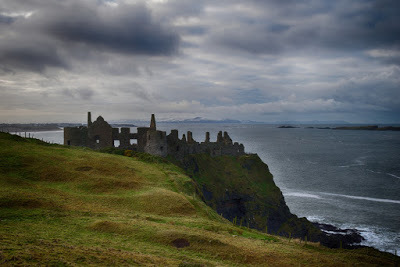
Further along the coast, we didn't exactly have the Giants Causeway to ourselves but compared to the crowds you get here in the summer, it was fairly empty.

The clouds competed with the rock formations for our attention...
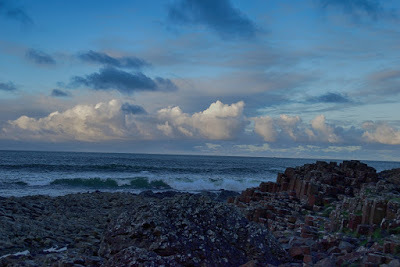
And stole the show, hands down, when the sun painted them in golds and bronze.
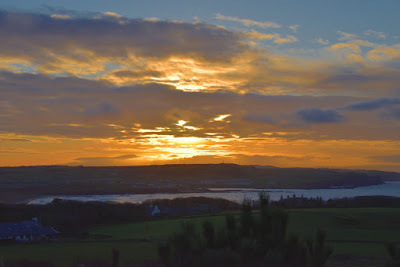
The highlight of the trip was the gorgeous Ballintoy Harbour, also seen multiple times on Game of Thrones. In that world, it's part of the Iron Islands where Theon Greyjoy's family hails from. In real life, it's actually far prettier.
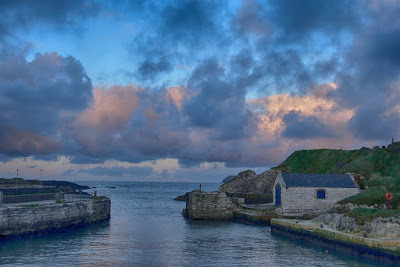
But it's easy to see why someone would base a fantasy story here.
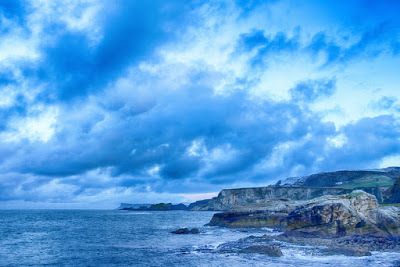
As a whistle-stop tour of the North Coast goes, we did fairly well to see so much before it got dark. I would recommend spending a few more days here and take some of the rambles along the coast... we've marked it on our to-do list for this summer.
Driving home, we came across this ethereal scene and had to stop the car to take photos of the theatre of cloud, fog and snow - fairyland indeed.
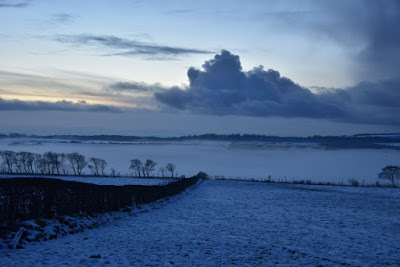
Is it any wonder Irish culture is so heavily sprinkled with fairies and magic when this is on our doorstep?
Byddi Lee

When they told us that they'd been up to parts of the North Coast before but hadn't managed to visit The Giants Causeway because of the queues of people, we decided we had to take them. It was January - sure we'd have the place to our selves (Ha - ya think?)
We left Armagh at 11am - we're into leisurely Saturday mornings - and arrived in Portstewart at 1.30pm, just in time for lunch.
The sun was at it's highest but at this time of the year, at this latitude that's not saying much. Huge white clouds chugged across the sky accentuating the gorgeous landscape and providing a feature all of their own. Precious chunks of blue sky peeked from between them and brightened patches of a pewter ocean to Azure.
Our first stop along the road was Dunluce Castle. The first time I saw this place, thirty odd years ago, (some years odder than others, believe me) I was driving the coast road from Portstewart to Bushmills and didn't know it was there. I turned the corner and BAM - this amazing castle on a cliff edge just sitting in a field. There was no wall or fence around it, no visitor centre, no cover charge - just this mad castle that you could walk freely around. Today the castle is still as splendid. So much so that it has been used, with the help of CGI technology, as a set for Game of Thrones - representing House of Greyjoy.

Further along the coast, we didn't exactly have the Giants Causeway to ourselves but compared to the crowds you get here in the summer, it was fairly empty.

The clouds competed with the rock formations for our attention...

And stole the show, hands down, when the sun painted them in golds and bronze.

The highlight of the trip was the gorgeous Ballintoy Harbour, also seen multiple times on Game of Thrones. In that world, it's part of the Iron Islands where Theon Greyjoy's family hails from. In real life, it's actually far prettier.

But it's easy to see why someone would base a fantasy story here.

As a whistle-stop tour of the North Coast goes, we did fairly well to see so much before it got dark. I would recommend spending a few more days here and take some of the rambles along the coast... we've marked it on our to-do list for this summer.
Driving home, we came across this ethereal scene and had to stop the car to take photos of the theatre of cloud, fog and snow - fairyland indeed.

Is it any wonder Irish culture is so heavily sprinkled with fairies and magic when this is on our doorstep?
Byddi Lee

Published on February 02, 2018 06:58
January 22, 2018
Slieve Gullion - Armagh's highest mountain
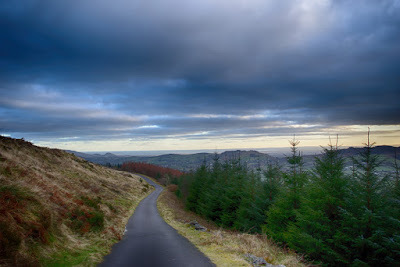
One of my New Years resolutions has been to get back into hiking. We plan to start slowly and build it up little by little. A great place for this is our very own local mountains in South Armagh, a half hour drive away.
Slieve Gullion is the highest point in County Armagh with an elevation of 573 metres (1,880 ft). We've climbed it before, in May 2016, with our nephews and friends (Super Man and Wonder Woman from the Mt Whitney trip). Unfortunately, the mountains that day were covered in thick fog and we were not able to see the small lake and two ancient burial cairns at the summit.
So when we found a Sunday in January that had crystal clear skies My Husband and I decided to have another go up Slieve Gullion even though it was only 2 degrees Centigrade.
It's been a decade since we spend time at this latitude at this time of the year. I never before realised just how tough the short days were. It gets dark at 4 ish, and the sun doesn't come up until 9 ish. I just feel lethargic all day. Some days the cloud cover is so thick that it feels like twilight all day long. I'm not complaining - at least I'm trying hard not to - I'm merely describing how it is...dark...
This lethargy means that it's a slow start in our household in the mornings - even slower than usual. We didn't begin our walk up Slieve Gullion until 3 pm with the result that we had to cut our hike short without getting all the way to the top but got to watch the sunset as we came back down again. An hour's walk was still a good start to our hiking plans - 3.7 miles and 900 feet elevation gain, according to Strava.
It gives us plenty of room to improve as the year progresses, as we get more hours of sunshine, and as the world around us slowly wakes up to springtime... I'm looking forward to it.
And no matter what time of year - the Irish sunset is hard to beat and can last for hours!
 Byddi Lee
Byddi Lee
Published on January 22, 2018 03:22
January 12, 2018
Flash Fiction Armagh - Call for Submissions
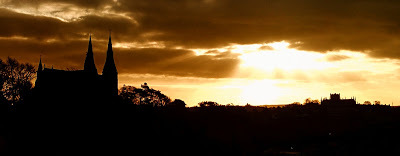
Flash Fiction Armagh is now open for submissions for inclusion at our public reading in our Flash Fiction event in Armagh City on 22nd March 2018 at Mulberry Bistro.
Deadline for submissions is 28th February 2018.
What is Flash Fiction Armagh?This is an event featuring Flash Fiction writers reading their work to an enthralled audience in Armagh. It differs from Open Mic in that the readers are selected ahead of time, based on their submission quality, and the evening follows a set programme.
Why?Flash Fiction Armagh provides a platform for writers to experience immediate audience reaction to their work – a valuable resource for those who sit all day in a room by themselves writing. We aim to entertain and provide an opportunity to mingle and make friends. We encourage people to attend the event whether they write, read or prefer to listen.
And the best reason of all - it's a bit of craic. Flash fiction Armagh is based on Flash Fiction Forum San Jose, California. Hop over to their website to see how they do things.
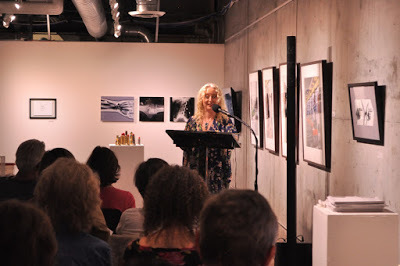 Reading at Flash Fiction Forum San Jose, Works Gallery, San Jose, CaliforniaWho?Entries are encouraged from:
Reading at Flash Fiction Forum San Jose, Works Gallery, San Jose, CaliforniaWho?Entries are encouraged from:· Experienced writers· Authors who can extract a short section from their books· Irish Language writers· New writers· Poets whose poetry reads like prose
How? Please email your 200 – 750 word submission within the body of your email (no attachments please) to byddi@hotmail.com with Flash Fiction Armagh in the subject line.
Réamonn Ó Ciaráin, Armagh author of Laoch na Laochra: Scéal Chúchulainn, and Chúchulainn: Ulster’s Greatest Hero, will help me curate the submissions.
It is free to enter, but please only submit up to three pieces of work.
You must be available to read at the event - Thursday 22nd March 2018, 7.00pm
If you are not selected for this date we reserve the right to invite you to read your submission at a subsequent Flash Fiction night.
We plan on having 3 or 4 per year, so no need to resubmit the same piece again.
We do not publish online or in print and you retain all rights. We don’t mind if you submit work that has been submitted elsewhere or that has already been published. Authors are welcome to bring copies of their books to sell.
When? Deadline for submissions is 28th February 2018. Flash Fiction Armagh is Thursday 22nd March 2018, 7.00pm
Where?Upstairs in Mulberry Bistro, Armagh, 6 Cathedral Rd, Armagh, BT61 7QX. Awarded Best Newcomer 2017.
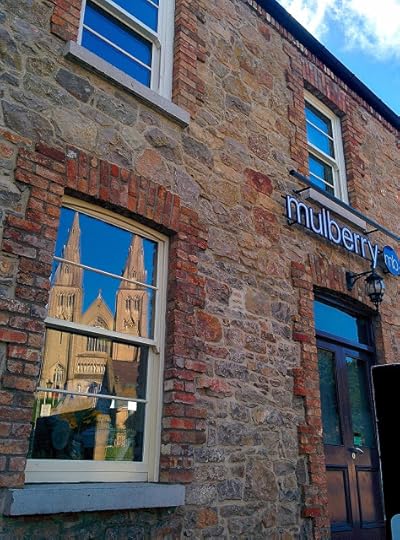
For more information about Armagh Writers and writing events in Armagh, have a look at their Facebook Page.
If you are a writer from or living in Armagh there is also a Facebook group.
Happy writing Flash Fictioners,
Byddi Lee


Published on January 12, 2018 11:25
Flash Fiction Armagh - Call for Submissions

Flash Fiction Armagh is now open for submissions for inclusion at our public reading in our Flash Fiction event in Armagh City on 22ndMarch 2018 at Mulberry Bistro.
Deadline for submissions is 28th February 2018.
What is Flash Fiction Armagh?This is an event featuring Flash Fiction writers reading their work to an enthralled audience in Armagh. It differs from Open Mic in that the readers are selected ahead of time, based on their submission quality, and the evening follows a set programme.
Why?Flash Fiction Armagh provides a platform for writers to experience immediate audience reaction to their work – a valuable resource for those who sit all day in a room by themselves writing. We aim to entertain and provide an opportunity to mingle and make friends. We encourage people to attend the event whether they write, read or prefer to listen.
And the best reason of all - it's a bit of craic. Flash fiction Armagh is based on Flash Fiction Forum San Jose, California. Hop over to their website to see how they do things.
 Reading at Flash Fiction Forum San Jose, Works Gallery, San Jose, CaliforniaWho?Entries are encouraged from:
Reading at Flash Fiction Forum San Jose, Works Gallery, San Jose, CaliforniaWho?Entries are encouraged from:· Experienced writers· Authors who can extract a short section from their books · Irish Language writers · New writers· Poets whose poetry reads like prose
How? Please email your 200 – 750 word submission within the body of your email (no attachments please) to byddi@hotmail.com .
Réamonn Ó Ciaráin, Armagh author of Laoch na Laochra: Scéal Chúchulainn, and Chúchulainn: Ulster’s Greatest Hero, will help me curate the submissions.
It is free to enter, but please only submit up to three pieces of work.
You must be available to read at the event - Thursday 22nd March 2018, 7.00pm
If you are not selected for this date we reserve the right to invite you to read your submission at a subsequent Flash Fiction night.
We plan on having 3 or 4 per year, so no need to resubmit the same piece again.
We do not publish online or in print and you retain all rights. We don’t mind if you submit work that has been submitted elsewhere or that has already been published. Authors are welcome to bring copies of their books to sell.
When? Deadline for submissions is 28th February 2018. Flash Fiction Armagh is Thursday 22nd March 2018, 7.00pm
Where?Upstairs in Mulberry Bistro, Armagh, 6 Cathedral Rd, Armagh, BT61 7QX. Awarded Best Newcomer 2017.

For more information about Armagh Writers and writing events in Armagh, have a look at their Facebook Page.
If you are a writer from or living in Armagh there is also a Facebook group.
Happy writing Flash Fictioners,
Byddi Lee


Published on January 12, 2018 11:15



